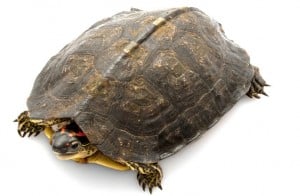South American Wood Turtle
Brazil, Colombia, Venezuela, Guyana and Trinidad
South American wood turtles need an enclosure with lots of ground space. A tank, Rubbermaid tub or other such container that measures at least 4 feet long by 3 feet wide can house two of these turtles. Of course, as is usually the case, larger is always better. These guys like to walk around, bask and hide under stuff, so make the space work for them. Height is not critical; the enclosure only needs to be tall enough to prevent the turtles from climbing out, or use a secure screen top.
Place a plastic tub at one end of the enclosure to serve as your turtle’s water area. This makes cleaning and changing the water easy; just lift the tub out, clean it, and fill it with new water before putting it back in.
Once the tub is in place at one end of the enclosure, add cypress bark to the other end, spreading it out and building it up until it’s nearly level with the lip of the water tub. Your turtle must be able to easily enter and exit the water, which should be deep enough to allow it to fully submerge. Again, the more room the better. Keep the water clean; either change it every day, or use a good-quality filter; though even with a filter, you’ll still need to replace the water and clean the water tub at least weekly.
On the opposite “land” end, place a hide that’s big enough for your turtle(s) to hide inside to feel secure. Artificial plants to snuggle under would be a nice addition, as well. Make the enclosure as cozy as possible while still providing an open area in which turtles can bask, as these guys like to do so. Add a bit of water to the cypress substrate; just enough so it’s a bit damp immediately beneath the surface, while leaving the top mostly dry.
Food bowls can be used, or do what I do, and place food on small paper plates, which are inexpensive and easy to replace. South American wood turtles have a habit of walking through their food, so easy clean up is a good thing.
As mentioned, these turtles like to bask, so place a heat lamp or emitter over the “clearing” that will serve as a basking spot. Use a device that will maintain a ground temperature of about 90 degrees Fahrenheit in the basking zone. The power/size of the bulb will depend on how far from the ground you will be positioning it.
I also recommend a fluorescent UVB lamp that runs the length of the enclosure. Turn all lights on in the morning and off at night, or put them on a timer that will do this.
If the temperature in your house falls to below 70 degrees at night, use a heat emitter and leave it on 24/7, or add an infrared lamp for nighttime use.
Wild South American wood turtles are omnivores that eat a large variety of foods, and the same goes for pet turtles. Leafy greens and some fruit, such as banana, grapes and melon, can be offered. They also will eat a variety of commercial aquatic turtle food, relish high-quality canned dog food, and will also accept crickets, mealworms, slugs and earthworms.
Over time you’ll learn how much food your turtles will eat at each feeding. A nice variety of foods is great to provide, but you will likely discover that your turtle will have its favorites, and may ignore the others.
Most South American Wood Turtles are imported from Guyana and surrounding areas. It is mostly adult turtles that are imported, and they usually arrive in pretty good shape. Healthy turtles will feel heavy and are bright-eyed and active, though I still recommend having new purchases checked by a reptile veterinarian for internal parasites.
You can find Rhinoclemmys punctularia at specialty reptile stores, online and sometimes at reptile shows. Captive breeding of is on the increase, and more hatchlings become available every year. Hopefully this trend will continue.
Colorful, of moderate size and easy to care for, South American wood turtles are very intelligent and learn to recognize their keepers. They are charming, and I highly recommend them. Plus, they’re great for beginners!
South American wood turtles can be quite fast, sometimes reaching a speed of up to a quarter-mile per hour if they’re in a real hurry.
Ken Foose produced his first captive-bred snakes at age 11. With a Master’s Degree in zoology, he has been both a zookeeper and curator. He opened Exotic Pets, which specializes in reptiles and amphibians, in Las Vegas in 1991. He is currently president of the International Herpetological Symposium.

